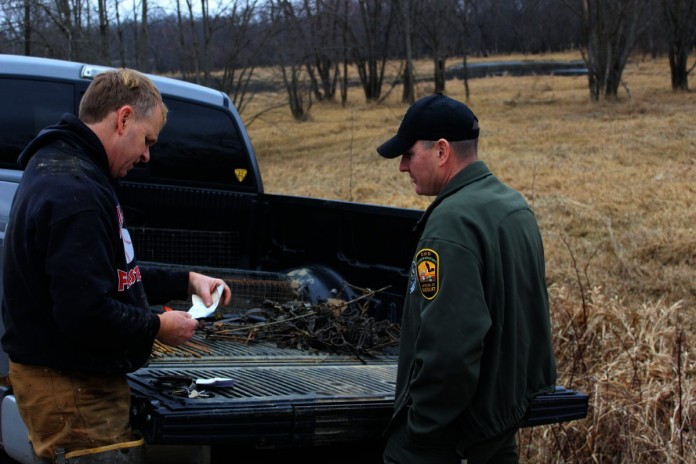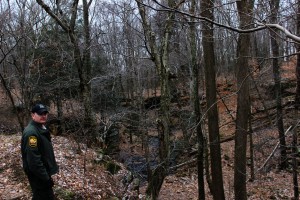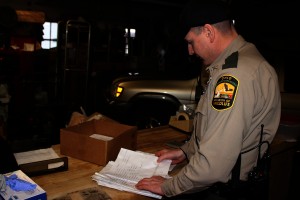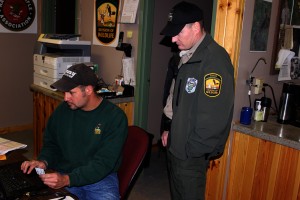(Scroll down for video of Ohio Division of Wildlife officers testing a deer for Chronic Wasting Disease)
NEW PHILADELPHIA, Ohio — Along a deserted roadway in the Dundee Falls area of Tuscarawas County, the black pickup is conspicuous. It sits, unoccupied, on the banks of a still, scrubby swamp.
“He is probably close,” says Wade Dunlap, Ohio state wildlife officer for Tuscarawas County. “They trap a lot of muskrat, raccoon and fox here, and beaver season isn’t in yet. If I was really hard core to talk to this guy, I could hang out and wait for him.”
Instead, Dunlap drives slowly past the truck and continues along the isthmus separating two swampy ponds. The wetlands appear, to the untrained eye, to be home to nothing more than bare tree trunks and tall marsh grass this time of year.
Several hundred feet down the road, drier land fans out in either direction, and Dunlap turns his pickup around at a railroad crossing.
He looks back up the road for a moment before driving back the way he has just come.
“Oh, there he is,” Dunlap says, pulling his truck to the side of the road opposite the parked black pickup.
A sandy-haired man in coveralls, mud-soaked boots, and a Tuscarawas County Trojans Girls Fastpitch Softball sweatshirt emerges from the surrounding woods.
Dunlap pulls on his coat and jumps out of his truck.
“What’s going on?” he shouts to the man.
The veteran trapper tells Dunlap that the morning has not gone too badly. But the single oily muskrat dangling from his armload of rusty traps belies his optimism.
Without being asked, the trapper shows Dunlap his license and a list of signatures of the property owners who have given him permission to trap on their land. Dunlap checks the traps for the required name and address, or customer ID, that each must contain.
“Some guys stopped putting the name and address on (traps) because a lot of people who are anti-trapping were going to their homes and harassing them,” Dunlap says.
Lifting the muskrat from the bed of the trapper’s pickup, Dunlap, himself a casual trapper, asks, “This is the only thing you got? No cool mink or anything?”
“No, but I saw some at a garage all skun and getting ready to be stretched,” the trapper replies.
The conversation goes on for several minutes, both men seemingly oblivious to the 29-degree temperature on this overcast winter morning.
“I do it for the fun of it,” the trapper says. “It’s tough; when the prices go up a bit, everybody is a trapper. But I even like it a little better when the prices are down. There aren’t as many out here.”
Innocuous on the surface, Dunlap’s questions also probe for tips about other hunting and trapping activity in the area. Information the trapper may, accidentally or on purpose, be apt to divulge.
The interaction, however, ends routinely.
“Well, it was nice to meet you and put a face to the name,” the trapper tells Dunlap. “We’ve spoken on the phone.”
As it turns out, Dunlap has been to the trapper’s house, when both decided that the trapper’s son needed an in-person tutorial from a law enforcement official about what a bad idea borrowing improperly tagged traps from a friend can be.
That meeting, the trapper assures Dunlap with a chuckle, had the desired effect.
An office on the road
Dunlap is one of 130 Ohio Division of Wildlife officers throughout in the state. The Ohio Department of Natural Resources divides the state into five wildlife districts — in the northeast, southeast, northwest, southwest, and central portions of Ohio — each with three wildlife supervisors.
Each county, however, is patrolled by a single wildlife officer.
“During hunting season, we handle a lot of hunting-related calls about things like licensing and road-kill deer,” the 14-year veteran says, noting that in Ohio it is illegal to possess any un-tagged deer, no matter where it comes from.
Dunlap’s work can range from speaking to classrooms and teaching hunter safety courses, to conducting nighttime stakeouts to catch out-of-season poachers.
The county sheriff’s department helps, but the majority of wildlife violations result in just warnings or citations. Only a small fraction, mainly drug- or alcohol-related incidents, result in taking a suspect to jail.
“That usually involves them having to ride handcuffed in the passenger seat,” Dunlap says of transporting violators in the already cramped cab of his pickup, filled with rifles, radios, and state-issued laptop.
The variety of the work has always been the most appealing part of the job to Dunlap.
“I grew up hunting and fishing and enjoyed it,” he says. “I always wanted an outdoor job and this was one more step. I had no idea going into it how much I would be doing.”
Unlike other law enforcement officers, Dunlap says, his position allows him to wear a number of hats.
“In most police work, an officer makes a stop, does a report and that is the end of it,” he says. “We do our own investigations. I may go do surveillance on a guy out in the woods and watch him. We always say you never know what tree we are going to walk out from behind. And if you are hunting without tags, I will cite you.”
Sportsmen themselves, Dunlap says, are often the divisions best eyes and ears.
“We may get information that a guy shot two or three bucks,” he said. “But we can’t just go knock on someone’s door. That’s why I tell people if I show up, I’m usually just getting some information to confirm something.
“And if I see someone parked along the road and I know ‘Oh, that’s Joe who always hunts here,’ or it’s the first day of hunting season and it may be some guy’s only chance to get out and hunt this year, I’m not necessarily going to go check on him.”
But sometimes, Dunlap says, officers do “strike gold.”
“I was called to a house once by a homeowner and when I got there I saw three or four illegal deer hanging in the barn,” he says. “They had simply forgotten to close the barn door before I got there.”
Paperwork
Like any job, a wildlife officer’s day is taken up to some degree by paperwork.
It is just before 10 a.m. as Dunlap pulls into Miceli’s Quality Meats in New Philadelphia to meet owner Audra Miceli.
After some small talk — Dunlap visits the county’s seven or eight meat processors to check paperwork twice a year — Miceli leads him to the dock area.
Deer gun season has just ended, and the meat hooks hanging from the ceiling are empty.
Miceli tells Dunlap that the company is still packing up deer for the county’s Farmers Feeding the Hungry program, as she hands him a pile of papers. The officer rifles through them in short order.
“Processors need to have the name, tag number, and county the deer was killed in,” he later explains. “Most of these places have it together — some use Excel spreadsheets. It is usually the guy who puts out a plywood sign and starts processing (who gets cited) and even then it’s just a matter of them needing to be educated.
“But ultimately, if I show up and there are six deer hanging with no tags, they are on the hook for possession of un-tagged deer.”
Before he leaves, Dunlap has one final question for Miceli.
“Do you have any deer heads?”
Testing for CWD
Since the state’s first confirmed case of Chronic Wasting Disease, a brain disease that is always fatal to white-tailed deer, at a shooting preserve in Holmes County late last year, the Ohio Division of Wildlife has redoubled its monitoring efforts in nine Holmes County townships.
The wildlife division hopes to test for CWD in the brain stems and lymph nodes of more than 400 road-killed and hunter harvested deer this season.
“The tough thing is, I can’t go stick a needle in a live deer and see if they have it,” Dunlap said. “You have to wait until they are dead.”
While the chances of finding fisherman in December is slim, Dunlap takes a trip through the Beach City Wildlife area — parkland unfortunately as popular for drug and alcohol arrests as it is for its natural beauty.
Dunlap pulls into a nondescript park entrance next to a beef cattle farm and shakes his head at the two bags of trash sitting near the mouth of a creek running through the property.
Litter and graffiti have become a constant and irritating addition to the landscape.
Farther up the road, Dunlap will later find three raccoon carcases tossed to the side of the roadway.
Other animals will take care of that litter, but Dunlap is still concerned about who may pass by and see them in the meantime.
Leaving the park entrance and walking just a few hundred feet into the woods, the landscape drops off into pristine ledges and a falls.
“You’d never know this is back here,” Dunlap says.
A fact that also makes the falls area popular with those looking for a place to drink and do drugs, he adds.
The long road to Killbuck
Back in his truck, Dunlap gets on the radio and continues his hunt for a deer head. After a few failed attempts, he locates one only a couple days old at a processor in Baltic, Ohio.
When he arrives at Baltic Meats, the deer head has already been packed up in a box — unusually thoughtful of the processor, Dunlap notes.
He tosses the box into the bed of the pickup. At 11:38 a.m., it will be a 40 minute drive across Holmes County to the Kilbuck Creek Wildlife Area where the deer head will be tested.
Lunch, it seems, can be skipped for now
An hour later, lab technician Chris Lepley is waiting at the testing facility at the Killbuck Creek Wildlife Area. He will remove the brain stem and lymph nodes from the 2-year-old, 8-point buck, which the tag indicates was shot on Dec. 4 in Coshocton County.
The process is surprisingly quick and simple as Lepley cuts into the neck of the deer and scoops out the tiny samples in under one minute.
The samples will be sent to the Ohio Department of Agriculture lab in Reynoldsburg, where a CWD determination should be made within weeks.
The day ends… almost
In more than a decade on the job, Dunlap has had his share of memorable moments. The most difficult by far, Dunlap says, have been the hunting related accidents, a number of which have been fatal.
On the upside, he says, technology advancements over the past couple decades have helped law enforcement take advantage of good old-fashioned human nature in very interesting ways.
“What’s the point of shooting a big buck if you can’t show it off?” Dunlap asks rhetorically. “People used to do that at sportsmans’ clubs. But now, with the advent of Facebook and stuff, that is where they are showing off.”
What they are often showing off is, he adds, oftentimes illegal.
And then there are those who choose to flaunt authority the old fashioned way.
Driving back into Tuscarawas County, Dunlap sees a man in a clearing alongside the highway, kneeling over the carcass of a deer. As Dunlap drives past, the man raises and waves a knife in the direction of the Ohio Division of Wildlife pickup.
““What the….oh, I don’t think so, Buckshot,” Dunlap says, hitting his overhead lights and pulling to the side of the road.
The wildlife officer walks into the field, hands cautiously on the butt of his service revolver, as the man with the knife stands up. Meanwhile, an Amish farmer rattles by in his wagon, oblivious to or completely unconcerned with the situation unfolding in the empty, frozen cornfield ahead of him.
It is a profoundly striking scene for, if nothing else, its unmitigated oddness.
In a couple of minutes, Dunlap returns to his truck and the man wanders away as mysteriously and unexpectedly as he had appeared.
“He was cutting the antlers off,” Dunlap says. “I would have issued a tag for the whole carcass, but I wasn’t going to give him one just for the antlers. Who does that? People see a deer along the road and jump out to cut the antlers off. I don’t even know what they do with them.”















Good read, Brian! My neighbor way down south in Ohio used to be the County Wildlife Officer. He would tell me stories that put the hair on my head on end.
These guys and gals are true professionals–we need to give them our praise and thanks!
Our grain farm was smack dab hard against a huge state park allowing public hunting and the Wildlife Officer would always stop by for a chat, ask: “What’s up?”, kept an eye out in the neighborhood, and would offer his ideas (all constructive.)
I could relate to some of real “characters” he ran across in his official duties, since a lot of these “city-slicker” jobs came to hunt the public land next to our farm. Most were ok, but a few were really unsociable, had few, if any, manners or decency, had no common sense, quickly became belligerent, and when you add in booze, crystal meth, and real hard drugs to a guy carrying a loaded firearm–well, let’s say it’s an interesting day.
If you’ve never had a loaded revolver poked into your nose at daybreak by a trespassing and drunken city-slicker hunter who thinks your farm is “public hunting land,” well–you haven’t lived. And you can really appreciate how Ohio Wildlife Officers live with these antics 24/7.
Ground deer antler is a common ingredient in many traditional Chinese medicines.